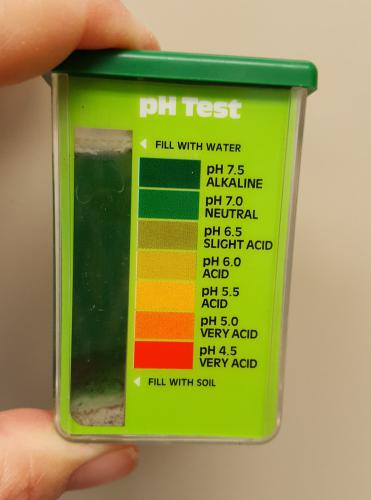It isn't fall yet, so why are my tree's leaves yellow?
Extreme pH levels and drought can cause chlorosis in trees. What are the clues?

This summer, there seems to be an increase in trees that are showing signs of yellow or pale green leaves, either occurring on a few branches or distributed over the entire crown. Usually the leaves are greenest along the leaves’ larger veins, then growing paler in between them. This chlorophyll loss is a primary symptom of chlorosis. In extreme cases, leaf edges may appear “scorched,” or leaves may drop prematurely. Species that are most susceptible to chlorosis in Michigan are pin or white oak, white pine, birches and red maple.
Many conditions can cause chlorosis in trees. The most common are various nutrient deficiencies, extreme pH levels or drought. Sometimes these conditions can combine to create more favorable conditions for chlorosis, and this past July’s heat and drought may have contributed to an increase in these occurrences.
Some nutrients that trees need to produce chlorophyll, including iron and manganese, may be deficient or depleted in the soils of some local areas. In other cases, excess potassium or phosphorus may actually limit accessibility of these critical nutrients. A principal cause of nutrient availability, however, is soil pH. Soils can be either acidic or alkaline, typically ranging from extremes of 7.5 (highly alkaline) to 4.5 (highly acidic) on an overall scale of 0 to 14. Urban soils in particular are more likely to be more alkaline, as are areas of the state with limestone bedrock. Sandy soils and special features like bogs are more acidic. In either case, if soils are above 6.5 or below 5.0, the nutrients needed for healthy chlorophyll production may be limited. The Morton Arboretum’s site contains more information on important soil characteristics.

With this pH test, the darker the green, the more alkaline the soil. Highly alkaline soils increase the likelihood of chlorosis | Photo by: Georgia Peterson, MSU Extension.
The most reliable way to determine current soil nutrient availability and pH levels is to order an MSUE home lawn & garden soil test mailer. After following the instructions and sending in a dried soil sample, an analysis summary is returned with nutrient level results and other soil information. The analysis also includes specific recommended treatments based on those results. A quick way to get relatively immediate (but less thorough) soil nutrient and pH results is to use a basic soil test kit from your local garden center. Kits typically contain tests for only three nutrients—nitrogen, phosphorus, potassium—and pH. Soil samples should be collected in a particular way to assure more reliable results. Ideally, samples should be taken in multiple locations around the tree, focusing under the tree’s crown and extending to the drip line (outermost branch tips of the tree). Dig down to at least 4-6 inches with a spade or trowel to collect the soil, since organic matter, roots and other debris can affect the results. Mix the various soil samples in a small bag to “average” the soil conditions, then follow the instructions in the test kit to measure the pH level.
So what can be done if the pH level is extreme enough to potentially limit nutrient availability, thus creating chlorotic conditions? First, be sure that there is no actual deficiency of iron, manganese, or other crucial nutrients by ordering a detailed soil test (described in the previous paragraph). The most straightforward actions are to eliminate competition for soil nutrients by removing all vegetation, including grass, around the tree, and replace with a thick layer of composted wood chips or other (natural) mulch material to maximize moisture retention. Also be sure to provide supplemental water during the summer’s extended dry periods.
Most chemical soil treatments for pH take some time to be effective. If the pH is high (alkaline), one option is to apply granular sulfur under the tree, all the way out to the drip line in the fall. Be sure to double check soil nutrient test results, and consult with a Michigan State University Extension master gardener or local garden center, for application rates and additional advice on keeping trees as healthy and green as they can be.



 Print
Print Email
Email




